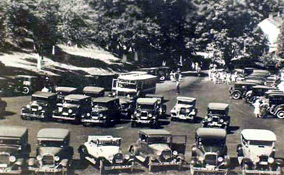On Sunday, November 12th, 1871, William Merkel and his assistant, John Gehret, were blasting for limestone on a farm owned by Merkel’s parents. At the time, crushed limestone was a valuable resource widely used by farmers to increase the fertility of soil.
To their astonishment, they noticed a dark, narrow hole in the side of the steep hill, eighty feet from Gideon Merkel’s farmhouse. They pulled away the surrounding dirt to reveal an opening large enough to penetrate. Once inside, darkness precluded further exploration.
The news of the potential cave discovery created much excitement in the small rural Kutztown community. Plans to explore this natural curiosity were made that same evening at a local tavern called Lesher’s Bar. Several adventurous neighbors, including John Gehret, went back a few days later equipped with ropes, ladders, coal oil lanterns, and torches. Their suspicions were confirmed. A good sized and well-decorated cave did exist on Gideon Merkel’s farm. Through word of mouth, nature’s silent development in the mountainside suddenly became big news.
A few weeks later, a group of 12 men organized an exploration of Crystal Cave. Once inside the cave, four of the men exited back outside and remained above ground. The rest of the group climbed through the cave for the next 1 ½ hours. They remarked about the sparkling diamond-like crystals that adorned the walls of the cave. As a result, the cavern immediately became known as Crystal Cave.
A local jeweler examined the small sparkling formations and determined they were not diamonds. Early explorers were disappointed by the jeweler’s assessment, however, their disappointment was soon replaced by joy when they realized the considerable dimension of the cave cavity and the abundance of ornate formations.
For the next two months, numerous curiosity seekers entered the open cave at their discretion. Fearful of vandalism and broken formations a neighboring farmer with a passionate hobby for collecting Indian relics and geologic specimens, leased the cave from Gideon Merkel in February 1872. Samuel D. F. Kohler, leesee, immediately erected a rudimentary wooden door to protect the cave from trespassers who could potentially damage the cave. A few years later a more appealing stout door replaced the wooden planks that were initially nailed to the side of the hillside.
No one was allowed inside the cave unless Kohler accompanied them. The next month, 31-year old Samuel Kohler purchased the 47-acre farm,including Crystal Cave, for $5,000, and became Pennsylvania’s first full time cave operator. The formal deed of conveyance was recorded in the Recorder of Deeds Office of the Berks County Courthouse on April 1st, 1873, more than a year after execution of the sale. (Deed Book Volume 492, P. 621-623.)



Interest in Crystal Cave was so great that as soon as Kohler leased the property he received word that a committee of men from a newly formed association of scientists, academic professionals, and enthusiasts of natural history were planning to study and report on the recently discovered cave in Richmond Township. They called themselves The Reading Society of Natural Sciences. For years Kohler reprinted their marvelous testimonial about Crystal Cave in various marketing promotions. In anticipation of his grand opening, Kohler labored fastidiously to remove unnecessary breakdown to create a suitable pathway inside the cave. He laid boardwalks and built wooden stairs and railings for safe passage.
He created a cave tour by identifying and naming familiar shapes of animals and other representations typical of the romantic landscape aesthetic movement of the mid-Victorian Era. Initial illumination to emphasize visual scenery came from using kerosene to ignite the walls of the cave and torches made by soaking rages in kerosene. Tallow candles and coal oil lanterns were additional sources of light.
Accessibility up the steep 80-foot incline to the cave entrance was facilitated by a grated path and a vertical series of rock steps. By late May 1872, Kohler announced the Grand Illumination of the Crystal Cave was to be held Saturday, May 25th, 1872. Admission would be $.25.


